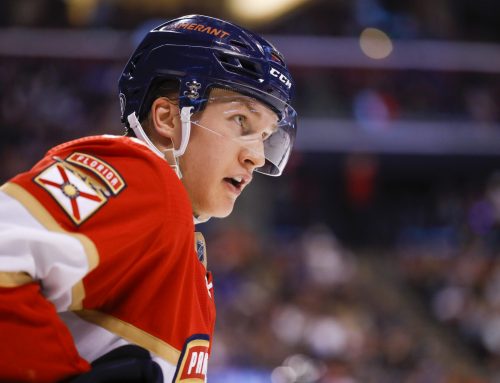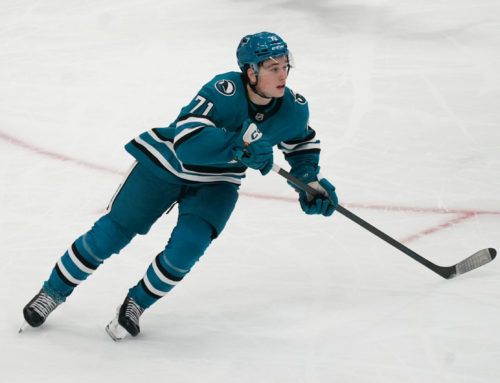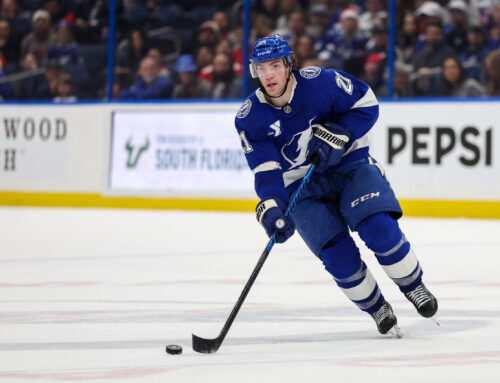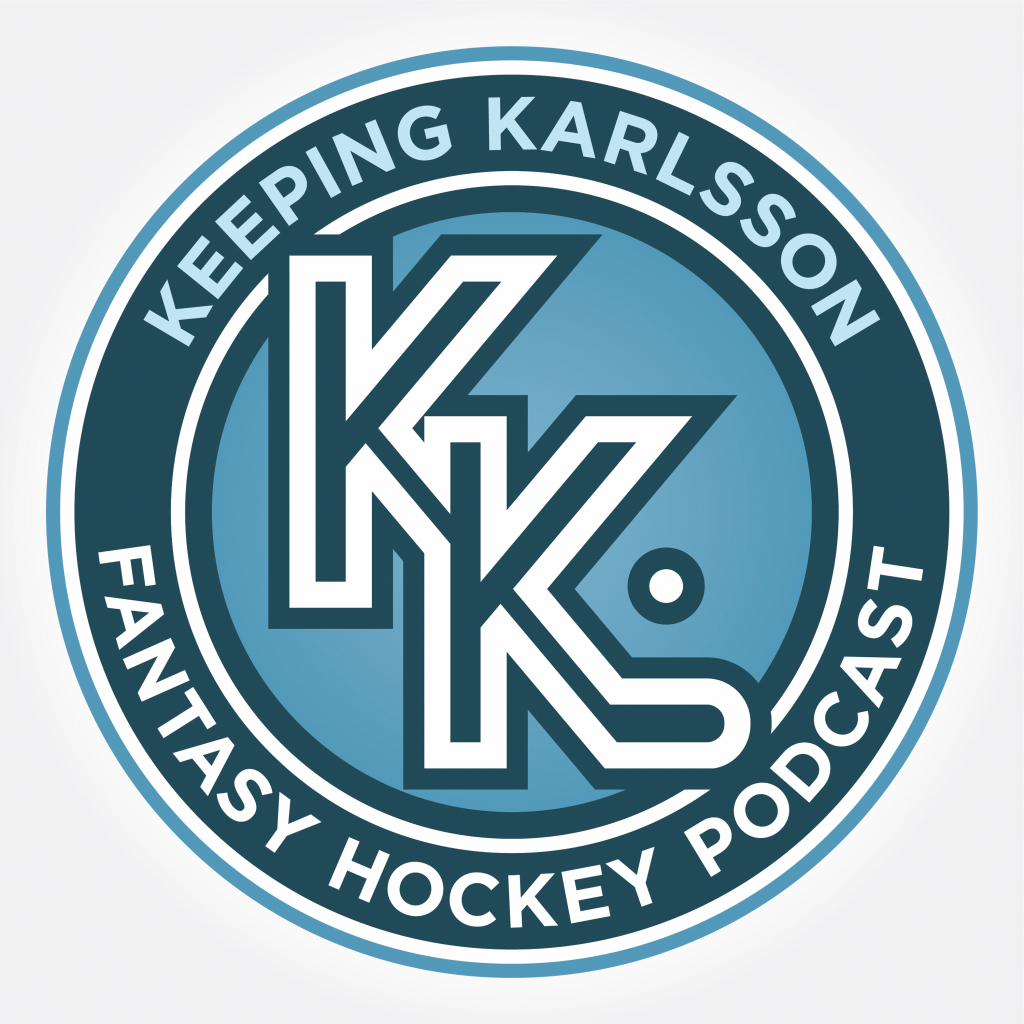Welcome back to Goldipucks and the Three Skaters, a play on words of the Goldilocks and the Three Bears story. Instead of there being three bowls of porridge though, I cover three skaters and declare one too hot (i.e., doing unsustainably better than he should), another too cold (i.e., doing unsustainably worse), and a third “just right” (i.e., producing where he should be). In addition, I also assign each a rating of 1-10, indicating how hot (rated 7-10, where 10 is the most unsustainably hot), cold (rated 1-4, where 1 is the most unsustainably cold), or “just right” (rated 4-7, where 5.5 is the most “just right”) he is.
As the dust settles after the trade deadline, it is difficult to assess players who were directly or even indirectly affected. For this month's Goldipucks, I've focused on three players (Lucas Raymond, Aleksander Barkov, Clayton Keller) not among those most impacted by trade deadline activity, but also for whom it might not be clear if they're too hot, too cold, or "just right." Before continuing, see if you can land on which label applies to which player, and then read on so you can find out if you scored a hat trick this month. Stats are current through March 14th.
Lucas Raymond (66 GP, 22 G, 46 A, 156 SOG, 19:01 TOI, 32 PPPts, 3:09 PP, 67.8% PP%)
Drafted fourth overall in 2020, Raymond spent another season in Sweden but was in the US and on the Wings for good starting in the 2021-22 campaign. He was strong out of the gate, with 57 points that season, only to drop to a 50-point pace for 2022-23, igniting concerns he was a one-year wonder. He allayed those worries big time by tallying 72 points last season, with nearly point-per-game scoring in the second half. For this season thus far, he's tracking to be above the point-per-game mark. Is this sustainable though? I'd say no, but only because it should only get better from here.
What immediately stands out is Raymond's gains in SOG rate, as he is up to 2.4 per game yet his SH% is actually below his career rate. There seems to be room for still more gains, as since the start of Q3 he has averaged right at three per contest. Yes, while this has occurred his scoring rate has actually dropped; but if he can be a 3+ SOG per game winger that's a big deal, since of 86 instances of 90+ point seasons from wingers dating back to 2000-01, only 15 occurred despite the winger not averaging 3+ SOG per game. To see Raymond at that level now suggests he has 90+ point scoring in him.
It’s also great to see that Raymond has already gone leaps and bounds above his previous high in PPPts. The interesting thing though is his PP TOI is not much higher than it has been in the past. Where he'd never taken the ice for even 60% of his team's PP time in any past season, he's at 67.8% for 2024-25. What this seems to suggest is Detroit has room to draw more penalties; and sure enough their PP TOI per game puts them in the middle of the pack. Yet their PP percentage puts them third. The conclusion instead becomes that they are so great on the PP that they score early and often, meaning their PP1 guys' PPTOI per game is not as high as it would be were it not for their success. Maybe then Raymond doesn't have realistic room to get more PPPts per game; but they might not remain unchanged, as of the two forwards with more PPPts than Raymond, both average 82%+ of their team's PP time. In fact, despite Raymond's prowess on the PP he's barely in the top-50 among forwards who've played 40+ games in terms of percentage of his team's PP time he sees. Long story short, despite Raymond's huge leap in PP scoring it looks to be very much for real, and maybe – just maybe – even have a chance to uptick.
On the other hand, is Raymond too dependent on PP scoring? If so, it's not his fault, as the Wings sit in the bottom ten in the league in Shots per game, and the bottom half in goals per game despite their success on the PP. As such, it leaves ample room for Raymond to bolster his overall scoring rate with more points not on the PP. Also, the Wings are shooting just 8.3% at 5×5 with Raymond on the ice, this after averaging 10.5% last season. So those around him are not doing him favors as far as non-PP scoring; but they can do better, as we saw in 2023-24.
If his teammates were better, he'd reap the benefits. That's because his overall IPP sits at a career best 72.3%, yet it's barely a jump from last season's 71.1% mark for his overall IPP. This is good news in two accounts, the first being once above 70% may be seen as a fluke, but twice makes it far more legit. Plus a small uptick in overall IPP despite major scoring gains is good to see, since if it had risen to, let's say, 80%, not only would his scoring rate increase be more suspect, but also there would be no room for further improvement. This is a win-win stat.
As for PP IPP, it's 71.1%, which is strong but not stratospheric. That is a very good sign for the same reasons. His previous high was only 62.1%, so this is a decent leap; but it really is the first season he's been on PP1 from start to finish. The results are showing.
The other key metrics to assess are OZ% and secondary assist rate. For OZ%, Raymond is doing all this despite starting 48.5% of his shifts in the offensive zone. That rate is up as compared to 44.1% last season, yet also leaves heaps of room for improvement, just as does the 5×5 SH% number. His secondary assists mark is below 50%, and in fact is on track to be the second lowest rate of his career, meaning he might not stand to gain many points due to that metric, but neither is he likely due to shed any.
I'll admit I was a skeptic when it came to Raymond; however, in my defense, much of what had concerned me, namely his SOG rate and PP usage and production, have been addressed in a big way only starting with this season. And even though he's far exceeding his best ever scoring rate, I'd say across the board he has room to see further gains. As such, his 2024-25 so far has been TOO COLD and he gets a rating of 2.75, as he should be a 90 point downside player going forward.
Aleksander Barkov (56 GP, 17 G, 43 A, 123 SOG, 20:23 TOI, 24 PPPts 3:21 PP, 66.5% PP%)
Amazingly it's been more than a decade since Florida grabbed Sasha second overall. He certainly has not disappointed, as although it took a while before he exploded, he's on pace for his sixth season in the last seven of a 90+ point scoring rate. After a 108 point pace in 2021-22, he's now seemingly settled into a 90-95 point range. Is this his new normal? I'd say no, except not because he’s primed to rise again, but rather to see his scoring drop.
Although there can be debate as to whether certain players are or are not indeed Band-Aid Boys, Barkov unequivocally is one, as he's missed 10+ games in eight of his ten 82 game seasons as an NHLer. Although there is an argument to be made that missed games can give one fresher legs, they also can – and do – take a cumulative toll. Or to put it another way, injuries heal and a player is deemed well enough to play again, not only does it take time to get back one's timing back and hit one's stride again, but invariably there is some degree of damage done that leads to a player doing worse. Cases in point are Taylor Hall, Torey Krug, John Klingberg and James van Riemsdyk, who are all certified Band-Aid Boys and saw their production crater by the same stage of their careers as Barkov.
Also concerning though is Barkov's SOG rate has steadily dropped each of the past three seasons and is on pace to do so again, from a high of 3.6 per game in 2020-21 to now just 2.2 per contest, a rate not seen from Barkov since his early days when he was still a point-per-every-other-game player. Yet despite this, his SH% is not up, but rather is right at his normal rate. And that is going to hurt his production in the long haul, even if it has barely done so thus far.
On the plus side, Barkov is seeing a lower percentage of PK time with each passing season; but the drop is not enough to compensate for his lower TOI overall. Also, Barkov is tracking for an OZ% of 57.3%, which would be the second highest of his career. If it stays this high, then great; however, I'd say that given his past numbers it's far more likely to go down, and perhaps by a good bit. That would not do him any favors.
Also, in looking at the last nine seasons, Barkov, though a center, has never had a secondary assist rate over 50%, and in fact it was under 40% in more seasons than not. Yet thus far for 2024-25, he's at 51.2; and given his past results, it shouldn't be this high. I can acknowledge that a bit of an uptick might be logical if indeed he is turning more into a passer than both a goal and assist threat; however, this is too much of a jump and suggests he's tallied some unsustainable points.
Then there are Barkov's IPPs, which, remarkably, are 76.9%% overall and 72.7% on the PP. I'd have expected those to be par for the course for Barkov, but not so. In fact, they would represent only the second time in the last eight seasons that Barkov was above 70% for either. That is glaringly unsustainable, even again if accounting somewhat for a shift in his style of play. It just is not something that happens for a player to suddenly factor into the scoring so much more after having consistently been in the 60s overall and more often in the 50s than not on the PP. This is a major red flag and quite concerning.
It's not all "bad news" though, as Florida is shooting only 7.9% at 5×5 with Barkov on the ice, which not only would be lower than what it was in the last three seasons, and six of the last seven, but in those other seasons it was 8.8% or above all but once. Still, even if that signifies that some points that should've come to Barkov will do so in the future, it will be nowhere near enough to offset points he's due to shed.
Barkov has had a fantastic career, including in fantasy. But he does seem to be showing his age and/or the cumulative effects of so many injuries. The result is he's less of a shooter and more of a passer; but even accounting for that, he's producing above the level he should be given his metrics, and, as such, his 2024-25 has been TOO HOT, and he gets a rating of 8.25, as he should be closer to a 75-80 point player going forward,. If you're in a keeper league, it might be time to explore moving him before this happens.
Clayton Keller (65 GP, 23 G, 51 A, 174 SOG, 19:18 TOI, 31 PPPts, 3:25 PP, 73.7% PP%)
Also a former top-ten pick. Keller was a full-time NHLer as a teen, which was not surprising since his team needed all the offense it could get. But after impressing with 65 points as a rookie, Keller took another four seasons to surpass that pace; yet since then hasn't looked back. For 2024-25 however, he's tracking to far surpass his best ever output. Can we count on it continuing though? From where I sit, the answer appears to indeed be yes.
Looking at Keller's metrics, here he is above a 90-point pace as a winger, yet not only is he not averaging 3+ SOG per game, but he's never reached that rate in his career. In Keller's case though, things are trending towards improvement in that area, as in Q3 he nearly averaged three SOG per game, and, likely not coincidentally, had his best scoring pace of any quarter in his career. Also, his TOI in Q3 was back up to 19:43, and thus far in Q4 it is over 20:00, plus his PP TOI per game is above 4:00, this for a player who not once in his career had even averaged 3:20 per game of PP time. All of this paints the picture of a player who is producing well without unsustainable ice times or SOG rates.
Let's also pause to consider the headwinds that Keller faced even as recently as two seasons ago when his scoring rate was 80 points, as Arizona was dead last in SOG per game, within the bottom five in goals per game, and the bottom ten in PP%. Last season was a step up, as they were in the middle of the pack in PP% and goals per game, despite still sitting in the bottom five in SOG per game. So you're probably thinking they've seen huge gains in order for Keller to be able to be doing what he's doing. Not so, as they are still essentially middle of the pack in PP% and goals per game, albeit a bit better, and they're in that range now too for SOG per game. The good news is one cannot write off Keller's scoring gains as being due to a rising tide lifting his boat. If anything, there's even more room for Utah to do better and, with that, Keller as well.
Also, although Keller's overall IPP is 82.2%, amazingly that is up only slightly from 80.0% last season. On the PP he's at 75.6%, which, although also very high, is actually down from 81.0% in 2023-24. As I noted when talking about Raymond, when it comes to IPPs, once is encouraging, but twice is for real. What we're seeing from Keller underscores that he is a points magnet, which is so key given there is finally talent surrounding him, making it so both more goals are going to be scored, but also that he should still continue to factor into that added scoring.
Shouldn't Keller be deemed "too cold" given all this data and seemingly room for more scoring, especially from the team around him? If we dig deeper, we'll see the answer is no, because it's not all great news across the board. With this boost in scoring has come a secondary assist rate of 56.9%, which does not seem extremely high when looked at in a vacuum, but certainly is for Keller, who was below 38% in each of the last three seasons, including one season at 22.4%. For sure that had led to quite a few points he likely would not continue to accumulate. Also, his OZ% is 59.4% after not being above 51.4% in any of the past three seasons, and below 49% in two of the three. Part of that is Utah improving as a team, so it is not likely to come crashing down; however, I'd say it is more likely to drop a bit versus stay the same, let alone improve.
Keller had always been a player held in high regard in fantasy, but especially after stepping up the past two seasons. Yet at the same time he was considered a player who was saddled with a team-induced ceiling. Now though, through a combination of his own talent and some improvement by his team, he's thriving. All things considered, what we see is what we should get, making his 2024-25 JUST RIGHT and giving him a rating of 5.25. If there are GMs who are skeptical as to whether he can keep up this pace and are trying to trade him thinking they're selling high, don't hesitate to grab him if you can pay in return less than what Keller's true value now is.
***********************
Questions for Mailbag
My next monthly mailbag has plenty of room for more questions. To get yours to me, you can either send (1) a private message to “rizzeedizzee” via the DobberHockey Forums, or (2) an email to admin@dobbersports.com with “Roos Mailbag” as the subject line.





 BUF
BUF NYR
NYR CHI
CHI CBJ
CBJ S.J
S.J VAN
VAN PIT
PIT ANA
ANA
